On Earthing, the Holistic Medicine Trend that's Consumed my Every Waking Thought
My doctor ordered me to touch grass and it has sent me into a pseudoscientific tailspin.
For the entirety of my adult life, routine psychiatric appointments have been an inconvenient constant. Though I rarely talk about it in detail, I have always been prone to fits of depression and suffer from an anxiety disorder, both of which impact my ability to think or really function at all if left unchecked. I hate these appointments, and I really wish that I didn’t need them in my life. That said, if there is one thing I take solace in, it’s the straightforward, predictable nature of this otherwise annoying necessity. There are almost never surprises, which I’m grateful for. I’m not looking for surprises when I’m talking to a doctor.
But during my most recent check-in, the nurse practitioner I spoke with did just that when she advised that I start “grounding”.
Initially – logically – I assumed that grounding had to be some sort of psychological coping strategy that used the word figuratively. However, it soon became evident that the nurse practitioner was talking about literally grounding. In an electrical sense. Alongside the familiar Wellbutrin/Prozac regimen that’s been prescribed to me for the better part of a decade, I was instructed to spend no less than twenty minutes per day outside, barefoot, in direct contact with the ground. According to her, this would serve as a means of evening out “energy imbalances” I might be experiencing.
My immediate knee-jerk reaction was that a patch of grass, no matter how idyllic, could not possibly have the miraculous healing powers capable of eliminating symptoms I’ve dealt with since approximately the second grade. But the fact that this advice came directly from a medical professional lent some degree of credence. Presumably, the person prescribing this peculiar practice underwent countless clinical hours and years of postgraduate studies. Surely, these experiences would have made her immune to spouting entirely baseless snake oil pitches.
Right???
So, I second-guessed my gut reaction and started looking into how exactly grounding (also known as earthing) helps the body. I’m including a footnote with a more detailed description1 of grounding theory for those interested, but here’s a rudimentary diagram that more or less covers how it (allegedly) works:
Though not necessarily an inflammatory disease, experts around the world have long suspected links between depression and inflammation (which is probably why it was suggested that I try grounding in the first place). But depression management is only the tip of the iceberg – a growing number of people believe that grounding directly benefits physical as well as mental health. Advocates consistently insist that grounding can, at the very least, improve circulation, speed up immune systems, and even regulate circadian rhythm.
To a certain extent, it’s difficult to argue that the reported positive effects of grounding in nature2 are entirely the product of a placebo. Numerous studies connect stress reduction with immunological and cardiovascular health, and a growing body of evidence suggests a correlation between recreational contact with nature and lowered stress levels. It’s entirely possible that spending time barefoot in a green space may indirectly3 improve the overall well-being of an individual.
A quick search revealed that my NP is far from the only person hooked on grounding. #Grounding has over 550 million views on TikTok, yields nearly 2 million results on Instagram4, and appears to have vocal, dedicated followers across the social media spectrum. In August 2023, USA Today posted an article that covered growing interest in the practice and offered tips on how to efficiently ground. The Wall Street Journal included brief concessions that admitted the implausibility of it all, only to profess that grounding poses little danger or risk outside of an occasional bee sting.
And perhaps at a surface level, there’s truth to that sentiment. Even so I couldn’t shake the feeling that something corrupt and hideous lurked behind the seemingly harmless call to touch grass.
My skepticism toward the idea of electricity-as-cure-all isn’t unfounded. For as long as electricity has been accessible, there have been people fervently advertising its ability to heal.
The idea of medical electricity dates back to at least the 1740s, and a few tinkerers even created unusual apparatuses that surgeons and doctors used in experimental treatments. Though the results of many such experiments were, as one authority wrote, “too uncertain to be worth mentioning,” surviving manuscripts suggest that physicians recognized that the field of medical electricity had the potential to be profitable. However, in those early days of trial and error, electricity was not understood or accessible enough to realistically be employed in healing.
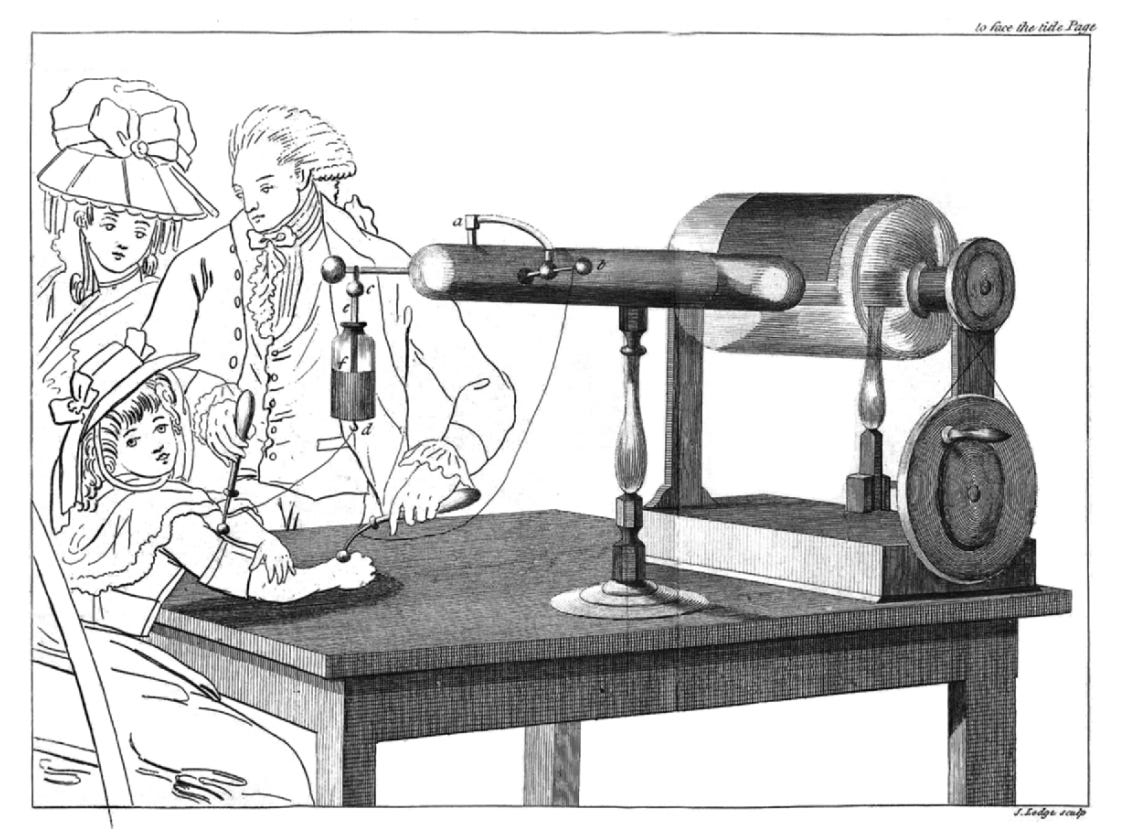
As we all know, things didn’t stay that way for long. The 19th century was a time of rapid electrical innovation, with influential scientists and electrical engineers like Michael Faraday, Thomas Edison, Heinrich Hertz, and Nikola Tesla more or less working in tandem. By the year 1900, the streets of major cities like Paris and New York were lit with streetlamps powered by thermal power stations, and a handful of wealthy homes were outfitted with electrical sockets that fueled the earliest incandescent lightbulbs.
Coincidentally, the 19th century was also an international golden age for medical quackery. Beginning in the late 1700s, there was an explosion of questionable patent medicine coming out of Great Britain. The business of marketing sensational cure-alls quickly spread across the (then expansive) British empire. When the Revolutionary War and the War of 1812 soured international trade relations between Britain and the United States, inventive American conmen started brewing medicinal tonics and elixirs of their own. Traveling snake oil salesmen peddled their wares westward, using theatric pitches that praised the therapeutic benefits of whatever they happened to have on hand. By the time unsuspecting customers realized they were swindled into buying sugar pills or salt water, the combination salesman/showman would have already moved on to the next town.
After a century of customers falling victim to blatantly false advertising and accidental poisonings, Europe and the United States finally started passing food and drug legislation regulating medicinal contents around the start of the 20th century. As random home brew remedies became increasingly difficult to sell, some career conmen revisited the idea of electrical healing. Though electricity was becoming an increasingly common fixture in everyday life, the phenomenon was still poorly understood by most people, allowing persuasive merchants to pitch electrotherapy as something quasi-magical. Better yet, electrical healing products bypassed early food and drug regulations5 by virtue of electricity not being a food or a drug.
Just three years after the formation of the US Food and Drug Administration in 1906, a physician by the name of Albert Abrams began purporting that he had the ability to diagnose and treat disease through a practice he dubbed radionics (or electromagnetic therapy). Soon after, he promoted an invention called the Dynomizer, which claimed to be able to diagnose any known disease from a single drop of blood6. Once equipped with a diagnosis, Abrams was able to “treat” ailments with a second invention called the Oscilloclast, which professed to treat various conditions by “harmonizing” irregular electronic vibrations occurring at an atomic level.
Abrams’ fantastic claims were fairly easily debunked by the American Medical Association7, and an in-depth exposé and investigation conducted by Scientific American further damaged Abrams's credibility. But even after being accused of quackery, Abrams retained plenty of believers8. A 1922 issue of the Boston Medical and Surgical Journal describes his written claims as “propaganda written up in a sensational way and very cleverly interlarded with a few scientific and many pseudo-scientific facts”. Thousands of practitioners were so convinced of the legitimacy of his claims that they’d lease machines from Abrams for hundreds of dollars per month (though only on the condition that lessees sign a contract agreeing to never pry open or examine the inner wirings of the device in question9).
After Abrams's death in 1924, a few radionic-adjacent scams came and went. Over the next several decades, a few naturopaths peddled devices that claimed to zap away parasitic infections10 or balance bioenergetic forces11. However, for the most part, electricity as a cure-all largely fell out of fashion.
But in the last twenty-five years, a man named Clint Ober has almost singlehandedly revived and remodeled the ideas that Abrams popularized for a modern (but equally exploitable) audience.
Ober has enjoyed a life filled with success. Despite being thrust into the workforce without much in terms of formal education, he somehow managed to pull himself up by the bootstraps so hard that he became the CEO of a cable installation and distribution service before reaching age 30. The Telecrafter Corporation subsequently became the largest company of its kind in the United States during a time of unprecedented cable demand. This success allowed Ober to spearhead a new endeavor in the early 80s called X*PRESS Information Services. Partnered with publisher McGraw-Hill and cable TV magnate TCI, X*PRESS was a subscription-based newsfeed aggregate that transmitted real-time data to personal computers using existing satellite and cable infrastructure12.
Through these business ventures, Clint became rich. So rich, in fact, that he admitted in one interview to having had “a quarter million dollars worth of art hanging in [the] bathroom over the commode”.
But in 1993 (or ‘94 or ‘95 – the details mysteriously vary depending on who exactly Ober is talking to), Clint discovered that he had a life-threatening abscess on his liver. Treated with the best modern Western medicine had to offer, he made a miraculous recovery. Approaching the brink of death, however, sent Ober into an existential tailspin. What’s more, X*PRESS was rendered obsolete by the ever-growing capabilities of the internet. After the product line was discontinued in 1997, Clint reportedly got rid of all of his belongings, bought an RV, and embarked on a soul-searching journey across North America.
While visiting Sedona, Arizona (or in some versions of the story, Key West, Florida), Clint noticed a gaggle of bypassers wearing sneakers with rubber soles and started to think about the repercussions, if any, that came from a life spent disconnected from the Earth. Intrigued by his own idea, he retrofitted his own bed with “metallic duct tape connected by wire to a ground rod” to simulate barefoot contact with the ground. Like magic, the aches and pains that had plagued Clint since his hospitalization significantly diminished.
The authenticity of Clint’s personal anecdote is, of course, impossible to confirm or deny. What we do know is that by the start of 1999, he was the chairman and CEO of a brand new venture – EarthFX Inc.
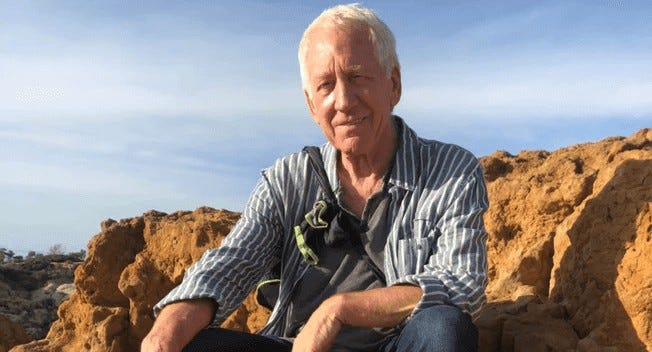
Since then, Clint has undergone something of a makeover. No longer donning the suits and ties of a stereotypical executive, he instead dresses in the jeans and t-shirts of a blue-collared everyman. Seemingly every photograph of Ober wearing shoes has been wiped from the internet. Instead of previously maintaining core leadership positions, he simply “worked” at Telecrafters and X*PRESS. He stopped talking about owning fine art in splashing range of his own piss and of picturesque holidays spent skiing in Breckenridge. But he did reminisce on his boyhood as a ranchhand, living in the still-untamed borderlands of Montana and Wyoming, where the neighboring Cheyenne and Crow families in all their ancient wisdom would insist that there was something inherently unhealthy about shoes and that the land itself had inconceivable healing powers
While it’s difficult to say what Clint might have been before he started leaving a digital footstep and was simply an anonymous rich guy, I can say with confidence that what he presents today is something meticulously crafted and curated. Through careful omission and emphasis, he has transformed from one of them to one of us. He no longer wants your hard-earned money. Just the opposite. He is the holder of secret knowledge, the kind that faceless (but very real) elites don’t want you to know because it would dismantle the profitability of the medical-industrial complex irreparably.
But what exactly is that revolutionary secret?
And more importantly, is there any truth to it?
The story goes that after Clint noticed positive results from grounding his bed, he ventured out to UCLA in hopes that researchers on campus might be able to offer an explanation. Instead, he recounts, “they pretty much laughed me off campus”. Rejected by the scientific community, Ober had “no choice” but to organize his own case study. He plastered advertisements for a sleep study across ten Ventura County beauty salons, ultimately gathering a total of 60 participants.
At a glance, the results Clint gathered are impressive. 100% of grounded subjects reported improved sleep and/or pain levels. A number of sources cite these incredible findings as the catalyst that launched all future grounding research. But a brief glance of Ober’s methodology immediately calls into question the legitimacy of his results.

Firstly, the very limited information provided in the initial report suggests that this particular study was unblinded, meaning that participants were aware of the treatment that they were (or weren’t) receiving. Unblinded studies are notoriously capable of yielding inaccuracies in subjective responses due to placebo effect. Furthermore, Ober’s study lacked any sort of quantifiable data and instead relied entirely on the subjects to self-report – despite the fact that individual perceptions were likely influenced by the unblinded nature of the study.
The issues in Ober’s methodology passed by unnoticed because the findings weren’t published in an academic journal, and thus never underwent the scrutiny of peer review. Instead, Ober opted to forward his report to ESD13 Journal, an online trade magazine. By the publication’s own admission, Ober’s work was not vetted by ESD before publication. A disclaimer preceding the study reads as follows:
“This technology has not been reviewed for its validaty by the technical staff of the ESD Journal. In some cases we may have either supporting or desenting opinions. However, we publish, you decide.”
In 2001, just after the publication of Ober’s findings on ESD, the Earth Tether International Corporation filed a patent for a “personal body grounding system” that lists Ober as the inventor – eventually, ownership of the patent transferred to EarthFX Inc. Shortly after the patent was granted in 2004, Clint began to directly facilitate scientific studies on the benefits of grounding by means of direct funding and donation of equipment. Within a matter of months, grounding made its debut in a bonafide peer-reviewed academic journal, lending the first superficial appearances of authenticity to Clint’s theories. Unfortunately, the academic journal that decided to publish those initial findings was the Journal of Alternative and Complementary Medicine, which reputable watchdog quackwatch.org once described as “fundamentally flawed”.
In the last twenty years, approximately thirty grounding studies have been published - a fact that the most adamant of grounders will quickly point to as proof of efficacy. However, 20% of those studies were published in the Journal of Alternative and Complementary Medicine. In addition, at least 35% of studies are tied to predatory publishers1415.
In short, profit-oriented predatory publishers take advantage of the pressure many researchers face to “publish or perish”. Journals tied to these practices solicit submissions for papers, then proceed to charge authors exorbitant publication fees. Because such operations are most concerned with profits, rejection rates are incredibly low and the contents of studies are hastily reviewed (if at all). This business model takes advantage of the pressure fresh scholars feel to get their names in print and (hopefully) advance their careers.
Perhaps more sinister than the predatory journals themselves are the individuals who use these predatory practices to publish flawed research that for all intents and purposes appears to be legitimate. For most academics, the price point of publishing is steep. But for someone who has ample funds and an agenda to push, paying a few thousand dollars per article is by no means a burden.
While it’s unclear who exactly paid the predatory publishers in question, it’s worth noting that Clint Ober has personally funded a great deal of the grounding research currently available. In fact, over 40% of studies openly acknowledge EarthFX Inc. (or Clint Ober himself) as a financial benefactor.
(If you appreciate works like this but aren’t necessarily interested in upgrading to a paid subscription, please consider buying me a coffee!)
This is not where the red flags end. Browsing through the studies, it quickly becomes evident that the majority of findings come from a very small group of interconnected researchers. For instance, 45% of grounding studies published as of September 2023 are authored (or co-authored) by a physicist named Gaetan Chevalier. Aside from his role as the director of the Earthing Institute and serving as faculty for Quantum University – billed as “the only institution of higher learning to provide degrees in natural medicine based on the science of quantum physics” – Chevalier is also an independent contractor for EarthFX Inc. This clear conflict of interest isn’t listed in all of Chevalier’s studies, and when it is, it’s easy to miss hidden among oft-overlooked acknowledgments crammed between conclusions and citations.
Though he’s the most prominently featured, Chevalier is not the only EarthFX independent contractor involved in grounding studies. The late cardiologist Dr. Stephen Sinatra also engaged in freelance work for EarthFX. Aside from authoring a few research papers on the subject of grounding, he and Clint Ober co-wrote a book in 2010 titled Earthing: The Most Important Health Discovery Ever. James Oschman (who penned the forward to the Ober/Sinatra collaboration) has also been contracted to conduct grounding research by EarthFX.
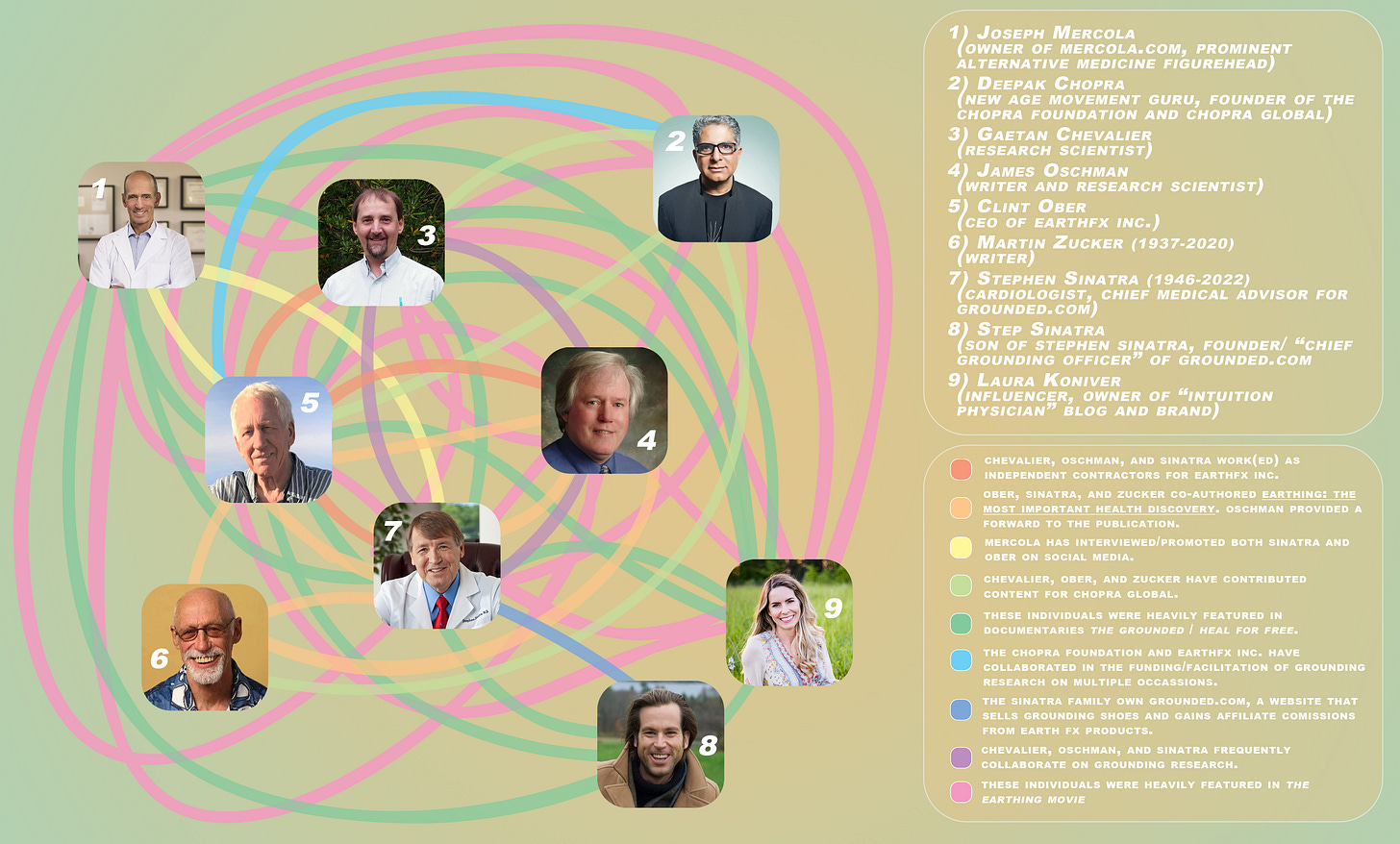
When discounting research conducted by individuals receiving payment from EarthFX, only about half of the existing evidence in support of grounding remains. The number wanes even further after subtracting pieces published in journals with known ties to predatory publishers. What’s leftover, as it turns out, is either not particularly compelling or riddled with issues. For example, a study titled “Prevention and Treatment of COVID-19 Infection by Earthing” penned by Haider Abdul-Lateef Mousa of University of Basrah was an entirely observational study that failed to define what it actually meant to “recover” from the illness16. Other studies such as “Electrical Grounding Improves Vagal Tone in Preterm Infants”, use very small groups of test subjects to draw conclusions that read as noncommital.
Having read this far, you may be wondering why so much has been pumped into funding studies, employing freelance scientists, and paying publication fees to the journals that compose academia’s underbelly. Ultimately, the answer to this question is pretty simple – for a select few, there’s money to be made in wholeheartedly convincing folks that grounding has immense, untapped power.
This may come as a surprise to some. After all, as those at the center of the movement are quick to retort, the act of taking off your shoes and sticking your feet in grass or dirt or sand is free. But early on, Clint (and a few others) realized that most regular people don’t have the luxury of unlimited free time to spend sitting barefoot in nature. The sick, desperate, and vulnerable that turn to grounding for relief may not even have the ability to physically to go outside.
So, aside from promoting awareness and facilitating research, EarthFX sells a variety of indoor grounding products that (supposedly) provide the same benefits that one (supposedly) gains from physically connecting to the earth. From $600 “Earthing Sleep Systems” to “Ground Therapy Patches” that claim to directly target problem areas, EarthFX Inc. (and by extension Clint Ober and his associates) has a vested interest in persuading the general public that grounding works. And through the manufacturing of materials that suggest legitimacy, the narrative becomes significantly more feasible.
To be fair, Clint is far from the only individual profiting from the increased popularity of grounding. Dr. Laura Koniver, who is featured heavily in several documentaries that commend the virtues of grounding, sells her own boutique eco-ethical grounding supplies alongside shields that claim to protect customers from EMF exposure. Step17 Sinatra, alongside his father Stephen, founded a website that offers a variety of third-party grounding footwear brands and proceeds to profit off of affiliate commissions. Celebrities in the sphere of alternative and integrative medicine like Joseph Mercola and Deepak Chopra promote grounding as a scientifically-backed, non-invasive holistic quick fix that compliments the miracle-working essential oils and pomegranate peel pills that pay their bills.
Whether or not there is any actual merit to grounding that we don’t yet fully understand, I can’t say with certainty. But what is abundantly clear is that the growing trend, as it exists today, is built mainly on lies and half-truths. The meticulously crafted everyman personas behind the brands and the flawed science alike are the natural evolution of those dishonest theatrical medicine shows that traveled the old Wild West 200 years ago.
The only difference is that the performance has been retrofitted for a society inundated with information and easily swayed by image.
“Insufficient grounding is the cause of inflammation,” Clint Ober explains 31 minutes into a Youtube video titled The Earthing Movie: The Remarkable Science of Grounding, “because if the body is anchored, it is not possible to have inflammation”.
At this point, it goes without saying that this claim is at best a gross exaggeration, and at worst an outright lie. But it’s a particularly clever lie, in that the word “inflammation” simultaneously acts as a placeholder for just about any ailment while skirting accountability for the deaths and injuries bound to happen when people forgo medical care in favor of grounding.
Hundreds, if not thousands of conditions are in some way linked to inflammation. The most adamant about the Earth’s healing powers insist with the utmost confidence that grounding can cure everything from cancer to COVID. Anecdotal claims state that grounding can provide quality of life improvements for children with autism. And while you’ll never hear a sales pitch that explicitly claims to cure lupus or Parkinson’s, organizations such as Dr. Chevalier’s Earthing Institute readily provide plenty of patient testimonials that claim as much.
At the same time, disclaimers in small print specify in no uncertain terms that the products for sale from companies like EarthFX are not intended to diagnose, treat, cure, or prevent any disease. For skeptics who might want to take action for a loved one’s wrongful death, individuals like Ober can point to such statements and truthfully say that grounding never claimed to be a cure for any illness. For the believers who might question why someone who partakes in grounding wasn’t cured, the narrative can be flipped entirely and tragedy attributed to not grounding sufficiently18.
But what’s particularly insidious doesn’t lie in grounding’s tendency to trick people into believing in a panacea that it simply isn’t. It’s the distrust that the whole manufactured story breeds in followers.
The hazards of grounding are perhaps best encapsulated in a TikTok post that I recently found from a relatively popular user who goes by Captain_Taylor_Morgan. While standing on a sunny riverbed, a physically fit, heavily bearded young man states the following:
“Right now, we are doing the healthiest thing that a human being can possibly do: we are outside in the sun, no sunscreen, no sunglasses, the full spectrum of UV light, while grounding in a natural body of water. THIS is freedom. THIS is independence. THIS is what the pharmaceutical industry does not want you to know. THIS is how you heal. Not all their pills that you pay money for. This: connecting with nature. This is how we heal and thrive.”
His poignant words reveal two interconnected but equally horrifying facts.
Firstly, it reveals that this particular disinformation campaign is complex enough that the old and digitally illiterate are far from the only people susceptible to falling prey. Specifically, Captain Morgan (and the grounding movement in general) gloms onto shards of truth that disillusioned younger generations know to be true. Hospitals, insurers, and pharmaceutical providers – especially in the United States – constantly engage in price gouging and subsequently profit off of people forced to choose between debt and death. Grounding threatens to dismantle that system because it is (technically) free. Naturally, some come to the (difficult to combat) conclusion that deep-state goblins would do everything possible to bury and discredit the virtues of the practice.
Secondly, grounding’s emphatic encouragement to question traditional Western medicine and the advice of doctors begins to skew truth itself. And though touching grass may not be harmful in and of itself, the rhetoric around grounding leaves people more susceptible to scams and practices that most certainly are. In the same breath as his grounding endorsement, Morgan also recommends that his viewers absorb “the full spectrum” of UV light. It’s been well-established for years that excessive UV radiation is a human carcinogen and that sunscreen use significantly reduces the chances of a person developing skin cancer. But if you’re grounding and thus preventing the inflammation that causes cancer in the first place, where’s the harm? Furthermore, if money and a little bit of cunning can so easily manipulate the research that serves as the foundation for our scientific truths, can we really be sure about what is or isn’t concrete, established knowledge?
This, I think, is the part that I struggle with the most. Although there are ways of surmising whether an academic journal is legitimate, and there are practices researchers and writers can do to increase the likelihood that a nugget of information is correct, belief in something as simple as the benefit of sunscreen is, for the majority of people, an act of faith. Most of us don’t have the knowledge base or resources to replicate or even fully understand the studies that support sunscreen use. So, we trust that those who distribute such information have humanity’s best interests at heart, above all else.
As this dive has indisputably revealed, that just isn’t always the case.
As an anxious person, doubt is my constant companion. Throughout the course of writing this, I’ve been filled with doubts along the lines of:
Am I understanding this study correctly?
Do the words I’m typing accurately relay what I want them to?
Is there something I’m missing that proves that this isn’t a blatant money grab?
Is there a difference between the doubt I felt in my gut while talking to my doctor and the doubt grounders feel when presented evidence contrary to their lived experience?
Am I being too harsh?
Maybe these uncertainties linger because I’d desperately like for grounding to vanquish things that cause suffering and death. I want to wake up tomorrow and be proven wrong. Nothing would please me more than to learn that for $69.99 (+ shipping and handling), I could buy myself a mat that will make all of the parts I hate most about my mind and body go away.
But I doubt it.
And, for the time being, I have no choice but to have faith in my doubts.
Most grounding materials will begin by citing the role of free radicals (molecules missing a valence electron) in the process of oxidation. Oxidative stress triggers an inflammatory response from the body’s immune system, which can, over time, develop into disease. Antioxidants, as the name suggests, prevent oxidation and inflammation by “loaning” spare electrons to free radicals. Our bodies naturally produce antioxidants, and some researchers believe that dietary antioxidants from “superfoods” like blueberries and kale can neutralize free radicals (although clinical trials have yielded mixed results).
The driving theory that grounding proselytizes posits that the negative electrical energy of the Earth’s crust can cancel out free radicals in much the same way. When something has a negative charge, the ions making up said thing have more electrons than protons. Grounding claims that when we remove insulative materials (like shoes with rubber soles) and connect directly with the Earth, those extra electrons can travel through our body and repair free radicals. The repair of free radicals reduces or eliminates bodily inflammation, which (theoretically) reduces or eliminates a litany of inflammatory ailments.
I’ll get into the (much more suspect) market of artificial grounding products later on.
It’s important to note that correlation does not necessarily equal causation, and there’s no evidence that the Earth is physically doing something to heal the human body. It’s also worth noting that none of the studies that I came across that linked health benefits to time spent outdoors specified that grounding was necessary to gain said health benefits.
(as of September 2023)
The FDA would eventually add amendments applicable to the safety and effectiveness of medical devices, but not until the 1970s.
The whole grift was very Theranos-era Elizabeth Holmes of him.
One oft-cited anecdote claims that an AMA member sent the doctor a blood sample that yielded results of tooth decay, sinus infection, and according to some accounts, cancer and syphillis. In actuality, the blood was sourced from a regular old barnyard rooster found to be in perfect health.
Ironically one of Abrams's most adamant defenders was journalist Upton Sinclair, whose novel The Jungle famously paved the way for a lot of the food and drug regulations that ultimately hindered the sale of phony elixirs and tonics.
Spoiler: inside was nothing more than some "simple wiring, a few resistors, a small motor that only made a humming noise"
Naturopath Hulda Regehr Clark claimed to be able to cure HIV and other serious illness via an expensive therapy she developed that centered around a battery-operated device she simply referred to as a “zapper”.
Desiree Dubounet’s Quantum Xrroid Conciousness Interface device, which was tied to the death of one leukemia patient scammed into abandoning actual medical treatment.
As antiquated as this technology sounds today, X*PRESS came before the general public had access to the internet. Though the technology would be rendered obsolete in a relatively short amount of time, X*PRESS thrived in its heyday.
ESD stands for ElectroStatic Discharge.
To name a few specifically, The Open Journal of Preventive Medicine and Health both have ties to Scientific Research Publishing (SCIRP), Healthcare and Biomedicines are attached to MDPI, and Frontiers in Physiology is a product of Frontiers Media.
Not all of the grounding studies are tied to predatory publishers. However, the majority of studies that aren’t are published in low-impact journals with limited readership. This doesn’t necessarily mean that the journal’s practices are purposely corrupt or dishonest, and there are well documented issues with judging a journal by impact factor alone. Still, low impact journals generally tend to have a smaller pool of research to choose from, leading to lower rejection rates. In addition, published findings are less likely to have significant influence and receive citations from subsequent supporting studies.
What I mean by this is that the researcher didn’t specify whether “recovery” meant that test subjects stopped testing positive for infection or just stopped exhibiting symptoms. In the context of COVID, which can linger for days after symptoms disappear, this seems especially problematic.
Yes, he goes by Step, not Steve.
And to be clear, this has happened at least one time. A participant in the H.A. Mousa COVID study cited previously ended with the death of two patients. The write-up claims that the cause of death can be attributed to the fact that “earthing was carried out insufficiently and too late” for the unlucky individuals in question.

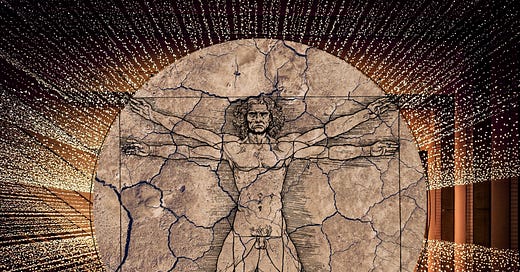



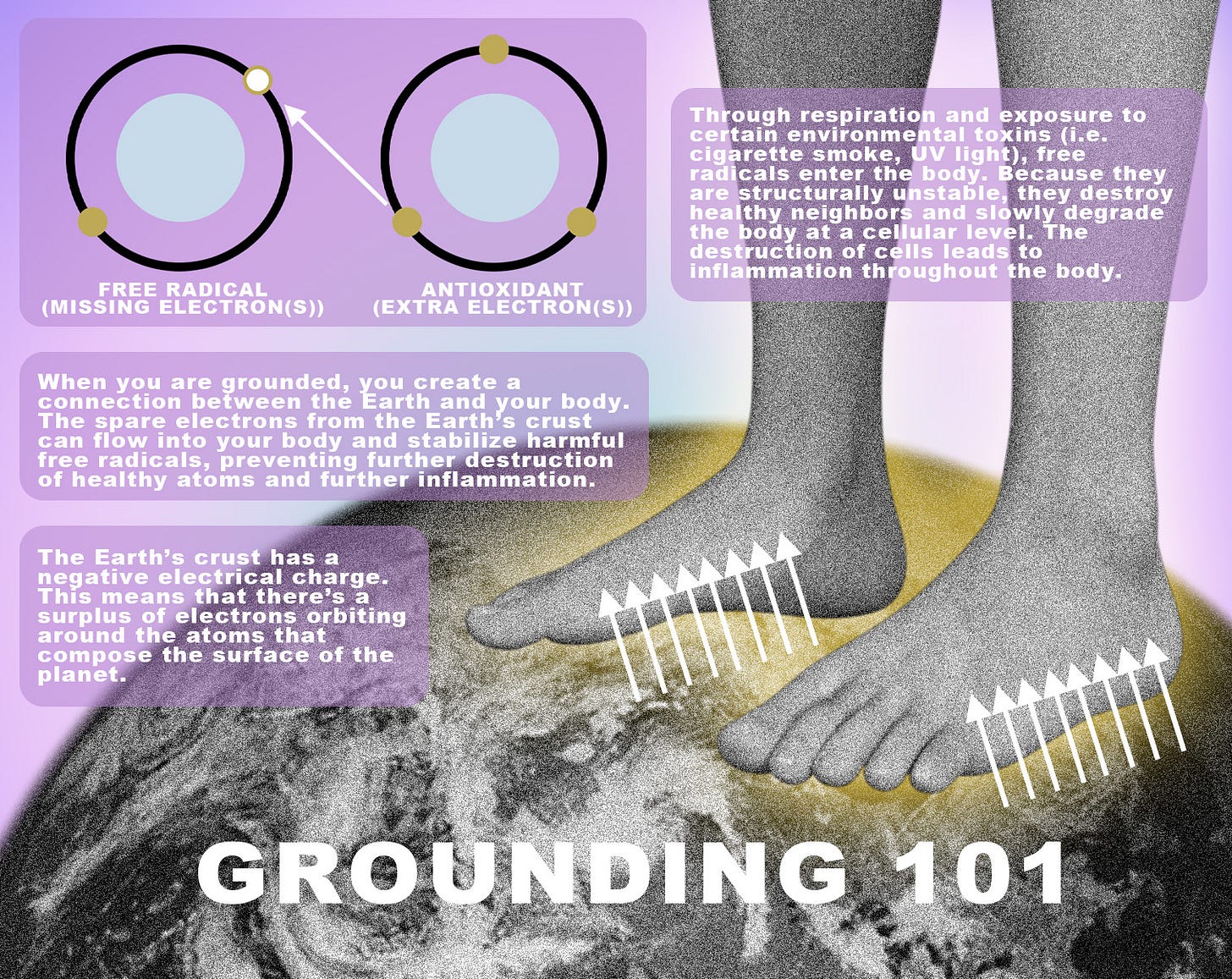
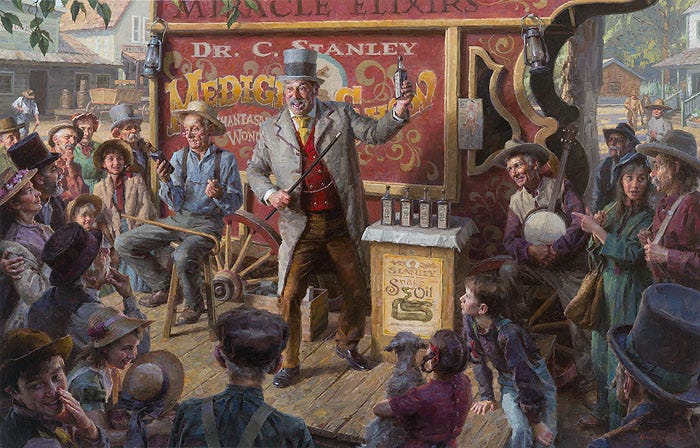
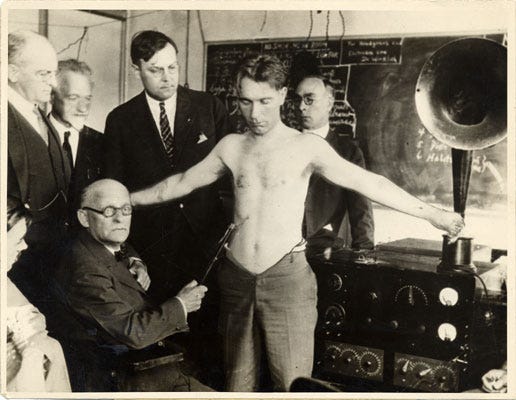

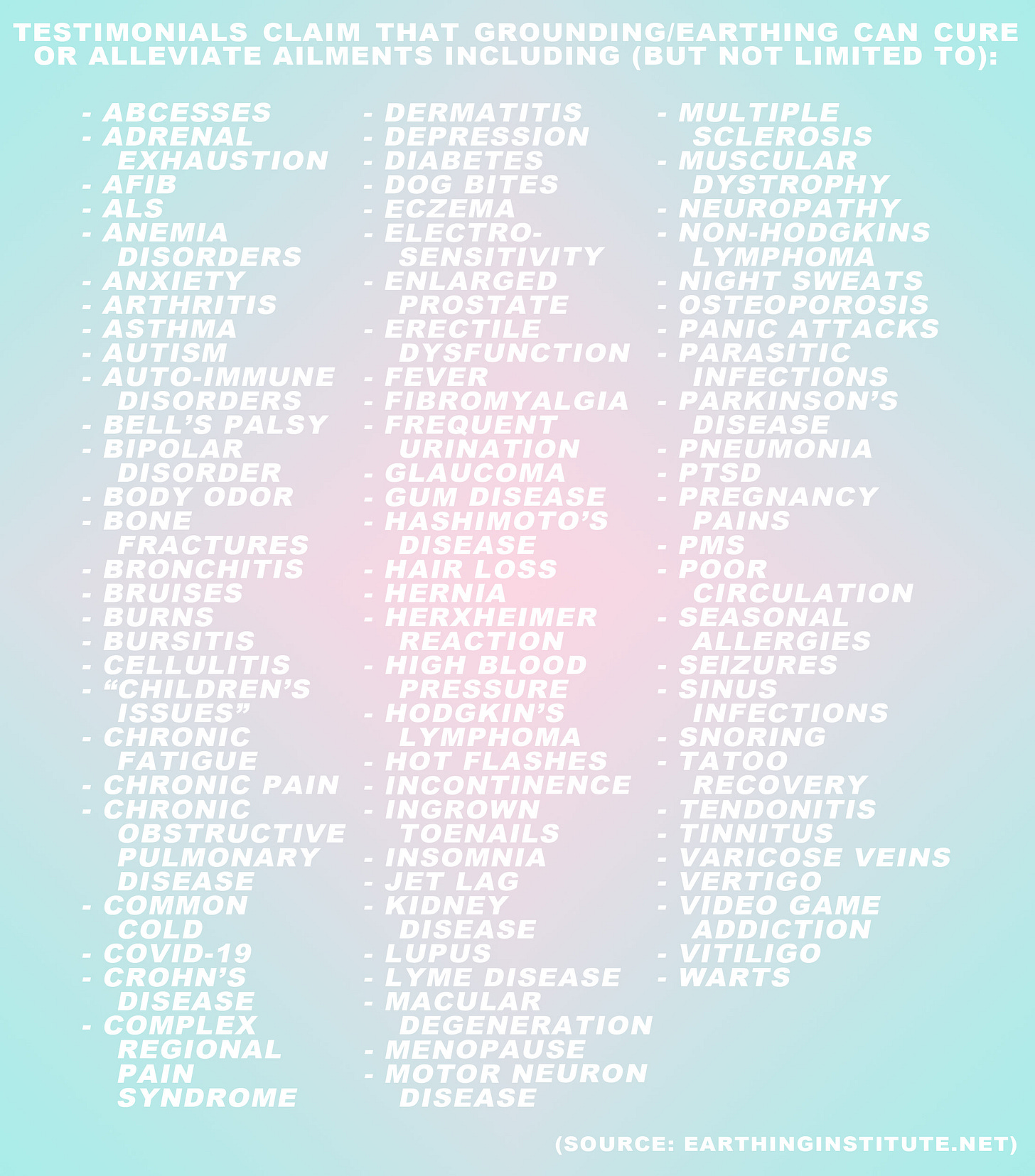
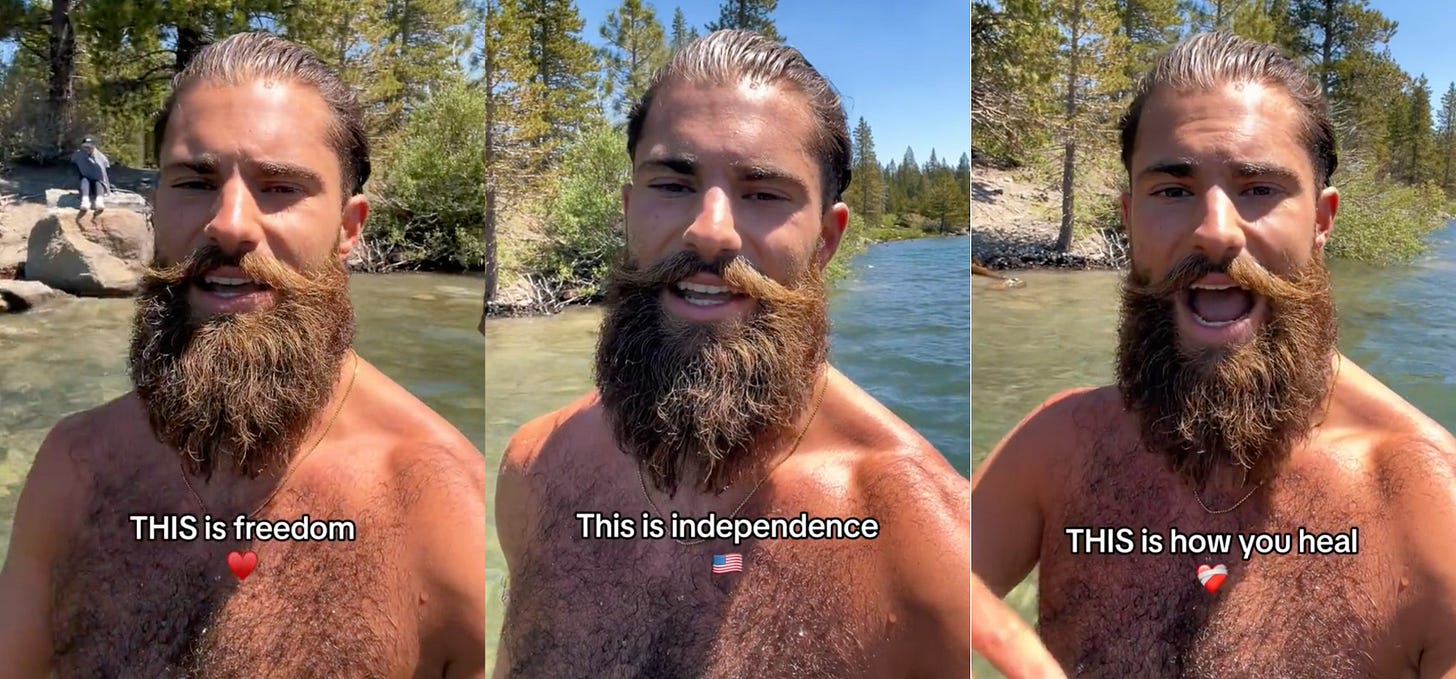
Fascinating piece! I’d heard of grounding sheets and knew they sounded fishy. You did the hard part for me 🫠